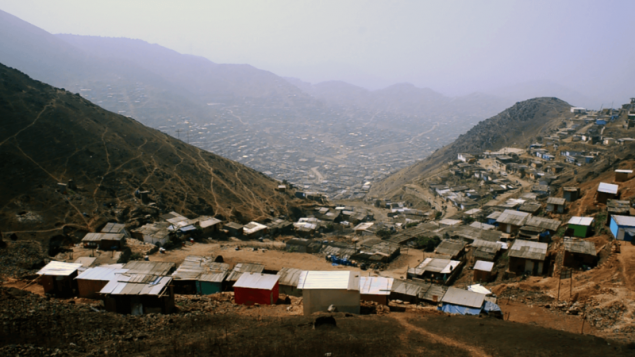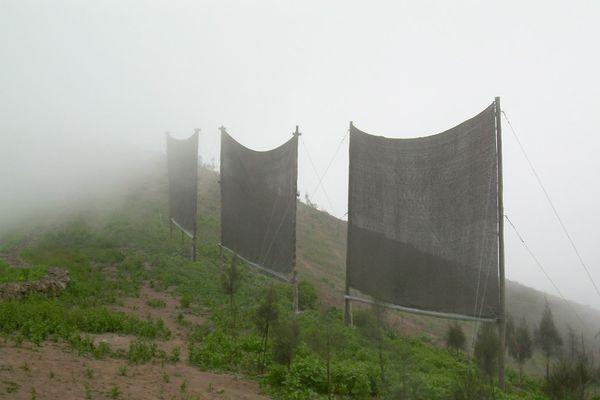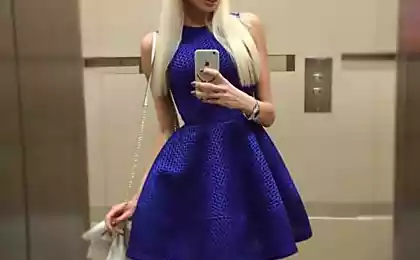537
Fog Catcher generates water
We have become accustomed to the fact that costs just turn the tap, it will flow a trickle of clear liquid. But on the ground there are areas where clean water is worth its weight in gold. Mentally, fast forward on the South American continent, in Peru, where residents of one of the high mountain villages are a free way to get water.

The settlers needed a cheap and reliable source of water supply. Boring artesian wells and install submersible pumps - no money
. Therefore, the villagers chose another option and mounted device that extracts water from the morning mist.

The collector is a cloth with polypropylene fabric in the form of a fine mesh, ranging from 40 to 70 square meters. m. The fabric is stretched on the ropes, between two metal poles driven into the ground.

At the bottom, just under the cloth is attached chute. Early in the morning, when the wind blows the fog, the moisture contained in it, due to the difference in temperature condenses and falls on a panel in the form of drops.

Slide down, drop, flowing down the gutter, fall into the plastic tube, the other end of which is displayed in pyatisotlitrovuyu barrel-header.

On average, the daily catchment system collects from 200 to 400 liters of water. By increasing the area of the reservoir, according to the calculations of engineers, the system can collect up to 1000 liters per day.
To save even more, the residents decided to abandon the use of a pump for the water supply. On hand he played terrain. Tanks of water are above the level of the village and the places set aside for crops. Thus the water is fed by gravity into the hoses and elevation provide sufficient pressure in the irrigation system.
The positive experience already interested people from other alpine villages. Moreover, based on the experience gained, the South Americans are advised to put the cloth, taking into account the wind rose, characteristic of a particular area. The wind must blow at an angle or along the reservoir, or, because of the large sail area, the pillars on which is mounted panel, can break or frustrate the canvas. Alternatively, in the event of high wind loads, you can use a grid with large cells, but it will reduce the amount of water collected.

In the future modernization of the sump. In particular, it wants to make a Quick-(this is true in the case of strong wind) and to supplement rain water collection system.

The settlers needed a cheap and reliable source of water supply. Boring artesian wells and install submersible pumps - no money
. Therefore, the villagers chose another option and mounted device that extracts water from the morning mist.

The collector is a cloth with polypropylene fabric in the form of a fine mesh, ranging from 40 to 70 square meters. m. The fabric is stretched on the ropes, between two metal poles driven into the ground.

At the bottom, just under the cloth is attached chute. Early in the morning, when the wind blows the fog, the moisture contained in it, due to the difference in temperature condenses and falls on a panel in the form of drops.

Slide down, drop, flowing down the gutter, fall into the plastic tube, the other end of which is displayed in pyatisotlitrovuyu barrel-header.

On average, the daily catchment system collects from 200 to 400 liters of water. By increasing the area of the reservoir, according to the calculations of engineers, the system can collect up to 1000 liters per day.
To save even more, the residents decided to abandon the use of a pump for the water supply. On hand he played terrain. Tanks of water are above the level of the village and the places set aside for crops. Thus the water is fed by gravity into the hoses and elevation provide sufficient pressure in the irrigation system.
The positive experience already interested people from other alpine villages. Moreover, based on the experience gained, the South Americans are advised to put the cloth, taking into account the wind rose, characteristic of a particular area. The wind must blow at an angle or along the reservoir, or, because of the large sail area, the pillars on which is mounted panel, can break or frustrate the canvas. Alternatively, in the event of high wind loads, you can use a grid with large cells, but it will reduce the amount of water collected.

In the future modernization of the sump. In particular, it wants to make a Quick-(this is true in the case of strong wind) and to supplement rain water collection system.
























